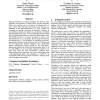94 search results - page 2 / 19 » Indexing Mobile Objects Using Duality Transforms |
STDBM
2004
Springer
13 years 10 months ago
2004
Springer
With the recent progress of spatial information technologies and mobile computing technologies, spatio-temporal databases which store information on moving objects including vehicl...
DEBU
2002
13 years 5 months ago
2002
Spatio-temporal databases store information about the positions of individual objects over time. In many applications however, such as traffic supervision or mobile communication ...
TIP
2008
13 years 5 months ago
2008
We consider the problem of recognizing 3-D objects from 2-D images using geometric models and assuming different viewing angles and positions. Our goal is to recognize and localize...
GIS
2003
ACM
14 years 6 months ago
2003
ACM
With the proliferation of mobile computing, the ability to index efficiently the movements of mobile objects becomes important. Objects are typically seen as moving in two-dimensi...
VLDB
2008
ACM
14 years 5 months ago
2008
ACM
Abstract Existing spatiotemporal indexes suffer from either large update cost or poor query performance, except for the Bx -tree (the state-of-the-art), which consists of multiple ...

